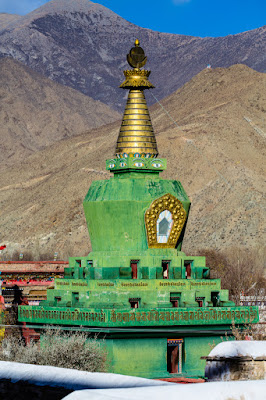Samye Monastery or Samye Gompa 桑耶寺 and another name for Samye Monastery is Samyuan. "Samye" is the Tibetan language which means"unimaginable". The Monastery is located in the quiet piedmont area of the Shanna region and it was the first constructed under
patronage of King Trisong Detsen (reigned 742-798) of Tibet who sought to revitalize Buddhism, which had declined since its introduction by King Songtsan Gampo in the 7th century.
There were many obscuration and obstacles to construct the Monastery. According to tradition, the Indian monk Shantarakshita made the first attempt to construct the Monastery while promoting his sutra-centric version of Buddhism. Finding the Samye site auspicious, he set about to build a structure there. However, the building would always collapse after reaching certain stage and many attempts to re-construct the Monastery but, eventually the building would collapse repeatedly. Terrified, the construction workers believed that the collapsed was caused by the local malevolent demons in a nearby river.
When Shantarakshita's contemporary Padmasambhava arrived from northern India, he was able to subdue the energetic problems obstructing the building of Samye. According to the 5th Dalai Lama, Guru Rinpoche, Padmasambhava performed the Vajrakilaya dance and enacted the rite of namkha to assist Trisong Detsen and Santarakshita clear away obscurations and hindrances in the building of Samye.
The great Indian master Guru Rinpoche, Padmasambhava performed this dance in order to prepare the ground for the Samye Monastery and to pacify the malice of the lha , (local mountain spirits) and srin (malevolent spirits) in order to create the most perfect conditions. The 5th Dalai Lama went on to say that after Padmasambhava consecrated the ground, he erected a thread-cross — a web colored thread woven around two sticks — to catch evil. Then the purifying energy of his dance forced the malevolent spirits into a skull mounted on top of a pyramid of dough.
His Tantric dance cleared away all the obstacles, enabling the Monastery to be built in 767. The dance was memorialized by the construction of Vajrakilaya stupas — monuments honoring the ritual kilya (purba) daggers. There are four colored of Stupas, the white, red, black and green at the cardinal points of the monastery that represent the four Mandalas or the four Heavenly Kings where they would prevent and suppress devils and demonic forces from entering the sacred grounds.
Guru Rinpoche and his closest disciple Yeshé Tsogyal travelled all over Tibet and the Himalayas, and blessed and consecrated the entire land, especially: “the twenty snow mountains of Ngari, the twenty-one Sadhana places of U and Tsang, the twenty-five great pilgrimage places of Dokham, the three hidden lands, five ravines, three valleys and one region.”
Guru Padmasambhava made many prophecies about the future, and together with Yeshe Tsogyal concealed countless Terma teachings, in order to: prevent the destruction of the teachings of the secret Vajrayana; avoid corruption of the Vajrayana or its alteration by intellectuals; preserve the blessing; and benefit future followers. For each of these Terma treasures, he predicted the time for its revelation, the identity of the Revealer, and those who would receive and hold the teachings.
Thank you for reading, may you find peace and great bliss. With your support it helps to spread the Buddha’s precious teachings and turning the Dharma wheels in the world.
Aspiration For Bodhichitta
For those in whom the precious Bodhichitta has not arisen
May it arise and not decrease
But increase further and further.
Dedication of Merit
By this merit may we obtain omniscience then.
Having defeated the enemies wrong-doings.
May we liberate migrators from the ocean of existence.
With its stormy waves of birth, old age, sickness and death.
Note
I do not own or violated any infringement copyright of these pictures, Pictures courtesy and credit to the rightful owners.
Thank you for reading, may you find peace and great bliss. With your support it helps to spread the Buddha’s precious teachings and turning the Dharma wheels in the world.
Aspiration For Bodhichitta
For those in whom the precious Bodhichitta has not arisen
May it arise and not decrease
But increase further and further.
Dedication of Merit
By this merit may we obtain omniscience then.
Having defeated the enemies wrong-doings.
May we liberate migrators from the ocean of existence.
With its stormy waves of birth, old age, sickness and death.
Note
I do not own or violated any infringement copyright of these pictures, Pictures courtesy and credit to the rightful owners.









No comments:
Post a Comment
Note: Only a member of this blog may post a comment.